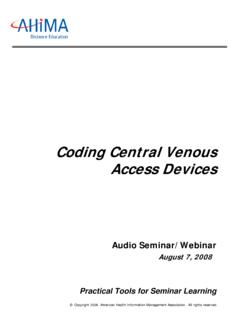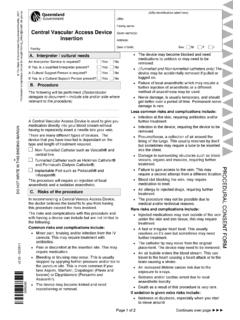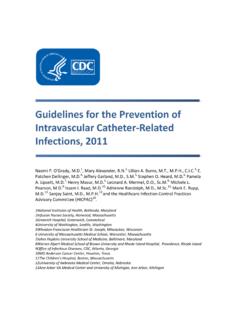Transcription of Neonatal Exchange Transfusion - Sydney Local Health District
1 Neonatal Exchange Transfusion IntroductionDouble volume Exchange Transfusion is mainly used for the management of hyperbilirubinaemia andhaemolytic disease of the newborn, when other methods of treatment such as early and intensive use ofphototherapy have been aim of an Exchange Transfusion is:To lower the serum bilirubin level and reduce the risk of brain damage (kernicterus);To remove the infants' affected red blood cells and circulating maternal antibodies to reduce red celldestruction;To correct anaemia and treat any potential for heart failure whilst maintaining disease: Indications for Exchange transfusion1.
2 Cord Hb < 12 mg/dl and/or cord SBR > 80: immediate Exchange transfusion2. Exchange Transfusion if rate of rise in SBR is such that SBR is likely to reach 300 micromol/L ( aimto keep SBR below 340 micromol/L)Informed ConsentBefore the commencement of any blood or blood product infusion the medical officer or registerednurse administering the blood product must ensure that parents have given an informed consent forthe procedure. Refer to the RPA PD2006_040 - Informed Consent for Transfusion of Blood andBlood Derived versus risk - In otherwise well babies the risk of Exchange Transfusion are usually small butin preterm babies who are unwell the risks of Exchange Transfusion are increased and the proceduremust be balanced the high morbidity associated with bilirubin of blood samples and ordering of Red Blood Cellsand FFP:Liaise with the obstetric team and notify blood bank of a possible Exchange Transfusion before thedelivery of an Rh- affected fetus.
3 Refer to the RPA 2007_047 Pre Transfusion Testing andadministration of Blood red blood cells (RBCs) have a predictable packed cell volume of 60% (+/- 2%) someasurement of haematocrit levels is no longer necessary. In order to dilute the RBCs by 10% youwill also need to order Fresh Frozen Plasma (FFP) of suitable request for RBCs for Exchange transfusions is normally considered an urgent request. The RBCsshould be ready within 2 hours of request provided antibody testing has been completed. To ensuretimeliness of the process, you should always communicate with the RPA Blood Bank (ext 58033).
4 Types of Red Blood Cells1. Rh haemolytic disease of the newborn: RBCs less than 5 days old are Rh negative RBCs do not have major blood group antigens so they are not haemolysed bymaternal antibodies that may still be present in the infant's the RBCs are made available before delivery of the sensitised infant the RBCs must be ORh negative and cross matched against the mother. If the RBCs are sourced after deliverythe RBCs must be cross matched against the ABO incompatibility: Use group O, Rh specific RBCs. These RBCs contain low levels of antibodiesand lack antigen that could trigger any circulating maternal antibodies in the transfusions should be done with RBCs that are compatible with that of the mother of RBCs and FFP to be orderedThe volume required is dependent on the reason for Exchange and is determined by the formula SINGLE VOLUME Exchange (anaemia with normovolaemia)Estimated blood volume depends gestational age and timing of cord clamping ranging from 53 -105 ml/kg/min.
5 Mean blood volume was 70 ml/kg (early cord clamping) versus 90ml/kg (delayedcord clamping for infants weighing single blood volume = 85ml x weight (kg)2. DOUBLE VOLUME Exchange (for established hyperbilirubinaemia or to preventhyperbilirubinaemia)Estimated double volume to be exchanged (ml) = estimated blood volume x 2 x infant weight (kg)Preterm/Term infant = 85ml x 2 x weight (kg) = 170 ml x weight (kg)Double volume Exchange removes about 85% of the infant's red blood cells. At the end of theexchange blood Transfusion the bilirubin should be about 50% of pre Exchange level.)
6 It willrebound at about 4 hours to 2/3rds the pre- Exchange blood (SSWAHS PD2009_05)A cross match request form MR175 must be hand written (addressograph labels are not acceptable) andcollection witnessed and signed by a second MO / RN. Specimen must be labelled by hand (addressographlabels are not acceptable).When ordering red cells for an Exchange Transfusion , remember the priming volume of the exchangecircuit is approx 50ml so additional RBCs should be communicate with blood bank ext 58033 Collection of blood and plasma from Blood BankBlood Bank will notify the nursery when the RBCs and FFP are ready to be collected.
7 The Ward Assistantwill need both the Intravenous Infusion Order Form (MR665A) and the RPA Blood Product Issue Form tocollect the blood products form Blood ProcedureAccess for procedure:Usually a 5 FG umbilical catheter is inserted to a level that allows free flowing withdrawal of blood pleasesee central line protocol for insertion and management of UVCs and exchangeThe preferred method in this nursery is the isovolumetric or simultaneous Exchange where access is via anumbilical venous catheter (blood in) and an umbilical arterial catheter (blood out).If either umbilical vessel is not available then the RBCs can withdrawn via a peripheral arterial cannula anddonor RBCs / FFP infused through a venous this method the RBCs are slowly withdrawn from the umbilical arterial catheter (or peripheral arterialline) in pre-determined aliquots with simultaneous replacement of donor RBCs / FFP through the umbilicalvenous catheter (or peripheral venous line)
8 Using the same aliquot The process should not be hurriedand should take a minimum of 2 hours or more depending on the volume of the pull methodWhen using the same catheter that is the RBCs / FFP are pushed in and pulled out through the sameumbilical venous catheter . The minimum time for this procedure is 2 hours or more depending on thevolume of blood to be of exchangeA suggested rate is 30 aliquots over 2 hours that is, 4 minutes each cycle. This is irrespective of whetherthe isovolumetric or push-pull method is volume for double volume Exchange :Aliquot volume (ml) = estimated blood volume x 2 x infant weight (kg) / number of aliquots in 2 hours= 85ml x 2 x weight (kg) / 30 EquipmentClean EquipmentSterile EquipmentClean dressing trolley with Lemex solution, leaveone minute & wipe dryBlue sterile plastic sheet to place under infusion pump (Allaris Signature)Infusate such as 10% dextrose - if exchangedelayedBieglerTM Blood Warmertape measuremasksprotective goggles if open ampoules heparinised saline (50units / 5ml)unopened solutions for skin preparation (aqueouschlorhexidine)Comfeel Leukoplast (brown tape)
9 Single lumen UVC (Argyle)5 Fg infants 1000g and Fg infants <1000g or <28weekssterile gown and two sets of sterileglovessterile green drapes (one fenestrated)dressing packumbilical drip insertion set (scalpel blade/ sutures included)L3 Exchange silk suturesterile linen cord tieadditional gauze swabsassorted needles / 5 ml syringesArterial line pack (optional)Emergency equipmentCheck T-piece positive pressure & suction equipment (8/10Fg catheter )Emergency trolley is checked, stocked and in close proximityPreparation of the infantInfants greater than 33 weeks gestation are placed on an open care system on servo mode tomaintain skin temperature at oC - see Thermoregulation less than 34 weeks are usually managed in an isolette The infant will require cardio respiratory and saturation monitoring set alarm limitsTemperature probe in situ set alarm limitsNIBP & cuff for blood pressure recording (if arterial line not insitu)
10 Evacuate gastric contents through a 8FG feeding tube and leave on free urine bag (infants > 30 weeks gestation) or cotton balls to collect and monitor urine also assists with maintaining a clean dry environmentHave oral sucrose & pacifier available to settle infant if neededIn additionEnsure informed consent has been obtained from parentsConfirm infant ID with the medical officer performing the procedureCheck blood and plasma with medical officer / second RN and sign the RPA Transfusion SheetPhototherapy using the Biliblanket (Ohmeda) should be continued during procedureOrganise pathology forms and containers for haematology (full blood count), biochemistry (sodium,potassium, magnesium, calcium, SBR, glucose) x 3 of each (for use during the procedure).






